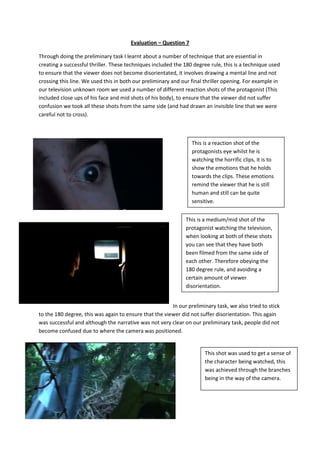
Evaluation question 7 - John Glen
- 1. Evaluation – Question 7 Through doing the preliminary task I learnt about a number of technique that are essential in creating a successful thriller. These techniques included the 180 degree rule, this is a technique used to ensure that the viewer does not become disorientated, it involves drawing a mental line and not crossing this line. We used this in both our preliminary and our final thriller opening. For example in our television unknown room we used a number of different reaction shots of the protagonist (This included close ups of his face and mid shots of his body), to ensure that the viewer did not suffer confusion we took all these shots from the same side (and had drawn an invisible line that we were careful not to cross). This is a reaction shot of the protagonists eye whilst he is watching the horrific clips, it is to show the emotions that he holds towards the clips. These emotions remind the viewer that he is still human and still can be quite sensitive. This is a medium/mid shot of the protagonist watching the television, when looking at both of these shots you can see that they have both been filmed from the same side of each other. Therefore obeying the 180 degree rule, and avoiding a certain amount of viewer disorientation. In our preliminary task, we also tried to stick to the 180 degree, this was again to ensure that the viewer did not suffer disorientation. This again was successful and although the narrative was not very clear on our preliminary task, people did not become confused due to where the camera was positioned. This shot was used to get a sense of the character being watched, this was achieved through the branches being in the way of the camera.
- 2. This shot was an over the shoulder shot as the character approached the teddy bear, as you can see from both these stills, they have been filmed again from the same side and therefore have stuck to the 180 degree rule. The next technique that we learnt about in the preliminary task, and have applied to the final cut of the thriller opening, is the ‘Shot reverse shot’ technique. This is the idea that in certain types of sequence (E.g. a conversation, if a conversation was to use the shot reverse shot technique it would involve there being a shot of one character and then a shot of another character and then another shot of the first character. This creates the feel that the viewer is in the conversation and allows the characters reactions and emotions to be shown. We did not use this technique in our preliminary task or our thriller opening; instead we put our own twist on this technique. Towards the end of our preliminary task, the tension is at its highest and we wanted to show this therefore we repeatedly went from a shot of the teddy bear to a shot of the character playing with the teddy bear, this was conducted extremely quickly and therefore created the fast pace for the climax of the preliminary task. Below is some stills that show this: In our final cut of our thriller opening it is a similar story, we had no dialogue and so could not use this technique unless we put our own twist on it. However we really were keen to use this technique as we learnt from our preliminary task that it was a great way to build tension. In the end we managed to use this technique in the television sequence, we showed some of the horrific images and then a reaction shot of the protagonist, to build the tension as if the protagonist was scared the viewer should in theory experience this too. This helped to make the clips all logically flow and run smoothly. Below there is some stills of the ‘Shot, reverse, shot’ technique in play.
- 3. The last technique I will be talking about in this essay, that I feel I have learnt from throughout the progression of the project is the match-on-action shot. A match-on- action shot is when two shots are connected together, in the second shot the character is finishing off the action that they previously started in the first. This was one technique that we did not use in the preliminary task or the final cut of our thriller opening. It is unfortunate that we did not use it as I feel that it adds energy to a scene and makes it a lot less repetitive and therefore would fit into the thriller genre really well; this is something that I would change if given more time to do this project. However having looked over the final cut for our thriller I did notice a place that relates to this technique indirectly. At the point where the protagonist is walking around the hospital looking for answers, there is a close up of a door handle being opened, which then fades into the protagonist walking in a corridor, although these two scenes do not necessarily link, they do in a way stick to the rules of the match-on-action technique. Below is some stills of this ‘hidden technique’ taking place. All in all I have learnt a lot about different techniques that can be used when making a film/trailer, that help to make it a success. These techniques have helped our thriller opening in a number of ways and have enabled our piece to be portrayed in the way it has.